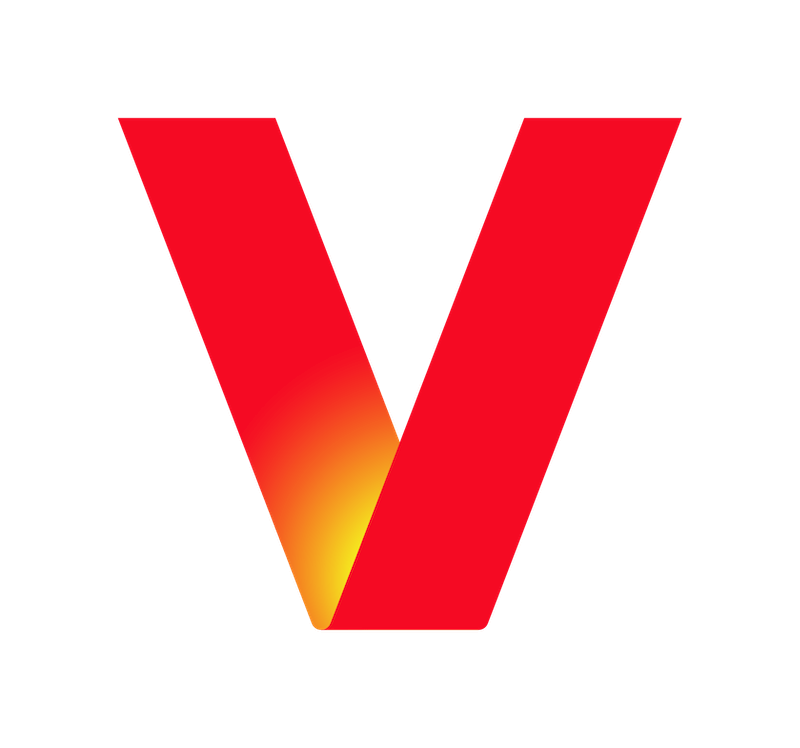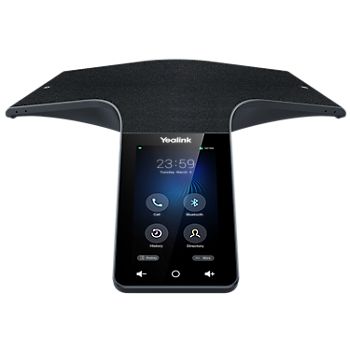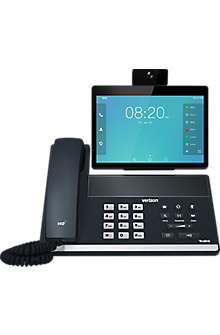commercial phone
Related Devices
Questions related to "commercial phone"
Videos related to "commercial phone"
Verizon Unplugged with Mel Robbins: Phone-Life Balance for the Family
Verizon: We've got your phone covered with Verizon Mobile Protect Multi-Device
Links related to "commercial phone"
Business Class Routers & Commercial WiFi Extenders
We've got some great deals going on right now Chat now to hear more! Business-ready speed, security and range. Retail price: $399.99 or $18/mo to rent,or,Retail price: $199.99 or $10/mo to rent,or call 877-740-0509,Verizon-provided routers and extenders provide fast and efficient internet connections or enhance your service for your small business. Technical support is available for Verizon-provided devices. Wi-Fi 6 and Tri-band 4x4 antennas are supported by extenders. Leverage the router that supports Verizon's fastest Fios internet plans, including gigabit-plus speeds. Learn more about our business routers. Explore more info about our commercial Wi-Fi extenders. A professional communications solution that works over a secure, cloud-based Voice over IP (VoIP) connection, making it easy to manage your calls on desk phones and through a mobile app to keep your business running. Inform your customers and add additional programming tailored to your business needs—all with the reliability of our fiber-optic network. The Verizon Router lets you take full advantage of our fastest Fios internet speeds. With next gen Wi-Fi 6E technology, Tri-band Wi-Fi and the new 6GHz Wi-Fi band, the Verizon Router also includes 2.5 and 10 Gigabit wired ethernet ports to support faster speeds in the future. For your protection, the Verizon Router is preset to use Wi-Fi Protected Access (WPA2) encryption for your Wi-Fi network. This is the strongest setting needed for most users and provides robust security. For advanced security needs, many other customizable features and settings are available to help secure your network. A business-class router is designed to scale and meet our customers' growing needs. The Verizon Router has the ports required to support 10 Gbps speeds, and up to five extenders for expansive Wi-Fi coverage. Additional Ethernet ports allow connections for business phones and other devices. The Verizon Router is designed for use in both residential and business environments. Verizon provides unique profiles to the router that tailor the functionality to each class of user. Verizon-provided routers come with quick-start guides as well as detailed user guides, which are available on our page. You can connect up to five Wi-Fi extenders to your Verizon Router, placing each extender in different hard-to-reach places to create an expansive Wi-Fi network. Our extenders and routers utilize the same advanced technology and offer easy plug-and-play installation. Extenders receive the internet connection via a router and extend the Wi-Fi coverage area so you can connect your devices in otherwise hard-to-reach spaces. Call sales,Chat with us,Have us contact you,Already have an account?,These cookies are necessary for the website to function and cannot be switched off in our systems. They are usually only set in response to actions made by you which amount to a request for services, such as setting your privacy preferences, logging in or filling in forms. You can set your browser to block or alert you about these cookies, but some parts of the site will not then work. These cookies do not store any personally identifiable information. These cookies allow us to count visits and traffic sources so we can measure and improve the performance of our site. They help us to know which pages are the most and least popular and see how visitors move around the site. We use both third party and first party cookies for this purpose. All information these cookies collect is aggregated and therefore anonymous. If you do not allow these cookies we will not know when you have visited our site, and will not be able to monitor its performance. These cookies enable the website to provide enhanced functionality and personalisation. They may be set by us or by third party providers whose services we have added to our pages. If you do not allow these cookies then some or all of these services may not function properly. These cookies may be set through our site by Verizon and third parties. They are used to present Verizon advertising on third party sites that you may visit. They do not store directly personal information, but are based on uniquely identifying your browser and internet device. If you do not allow these cookies, you will experience less targeted advertising from Verizon. BackClear Filters,All Consent AllowedWe use technologies to collect and share information about your use of our site. By continuing, you agree to the use of these capabilities for a better experience and other purposes. Learn more in our .
Learn moreHow Drones, Phones and Mini Cell Towers Can Benefit Public Safety
We've got some great deals going on right now exclusively for our online customers... chat now to hear more! Author: Rachel Engel,Date published: September 24, 2025,Drones, phones, and mini cell towers are some of the communication tools that can be used to create ad hoc wireless connections when communications are down. Advances in technology like these, in addition to COWs (Cell On Wheels), COLTs (Cell On Light Trucks), Satellite COLT, CROWs (Cellular Repeater On Wheels) and GOATs (Generator On A Trailer) are helping to put more detailed and clearer information into the hands of first responders. Connecting a mini cell tower, which provides the ability to transmit data to and from a wireless device, to a drone creates temporary, roving coverage. It's well known that public safety drones are equipped with high-resolution cameras that can help provide an of the scene. Public safety drones can also provide thermal images wirelessly to incident commanders on the ground, helping to protect their crews, predict fire directions, or help find a missing person. This can help in an area where a catastrophic fire or weather system may have damaged wired or fiber optic cables, or a cellular network preventing decision-makers from receiving critical information. Without constant updates and situational awareness, there could be serious repercussions for the work of first responders and public safety officials. Public safety drones turned into mini cell towers provide the ability for responders on the ground to send and receive information regardless of how much damage the immediate area has sustained. For instance, when approximately 1,084 homes and seven commercial properties and 6,000 acres have been burned down, like during the wind-driven Verizon provided the impacted areas with a variety of Verizon Frontline voice and data solutions and deployed many assets including cell on wheels to provide wireless coverage and capacity for emergency crews and responding agencies like the Red Cross. the cell on wheels stayed on site providing coverage during the last two years while the network towers were rebuilt. After caused significant damage in Florida in 2022, Verizon deployed drone technology with a temporary mobile cell tower site to provide 4G and 5G coverage. Hurricane Ian is a good example of the potential double-sided impact on connectivity after a natural disaster. Not only can existing communications infrastructure be damaged, but the increase in first responders, government officials and community organizations responding to the emergency alongside residents using mobile data due to home internet outages can result in significant network traffic spikes. For example, after Hurricane Ian, by more than 70% pre-storm levels in some areas. This is why solutions like drones with a mini cell tower can be a game-changer. For a more robust solution, mobile cell sites, such as cell-on-wheels, can be transported to areas in need of cell coverage following disasters. When public safety organizations are limited by a lack of network coverage and unable to access more accurate information, the temporary coverage provided by satellite, cell on wheels, a mini cell tower on a drone or other deployables can have a significant impact on operations, allowing critical information to be transmitted and potentially save lives. Additional use cases could include the use of tethered drones equipped with a mini cell tower to assist medical personnel working in field hospitals, providing broadband and LTE coverage to healthcare workers. Drones have already made an indelible mark on , with aerial surveillance providing a big-picture view of the targeted area and advancements such as thermal imaging providing uniquely valuable information. By adding a cell booster tower to public safety drone capabilities, first responders won't be limited by network coverage when searching for missing individuals, expanding the use of technology and increasing the probability of a successful mission. Researchers have discovered a way to with the help of a public safety drone equipped with a cellular base station. The search and rescue functioning drone can be flown over the search area to gather signals from mobile devices. A public safety drone can help first responders hone in on the missing individuals' device. As the drone traverses the area, the location of the missing person narrows and the information can be relayed to rescue crews on the ground. Known as the search and rescue drone-based solution (SARDO), the process to be used in locating an individual mobile device. By using rugged mobile devices, first responders can connect to body cameras or monitor the use of emergency vehicles. Options such as provide frontline workers a reliable way to talk, text and stream live video with the push of a button, from nearly anywhere in the U.S. For 30 years, Verizon's mission-proven communications solutions have helped first responders stay connected on the front lines. Verizon's intelligent platform automatically provides prioritization and preemption to first responders' voice and data communications so they can stay connected when it matters most. The use of modern technology continues to help eliminate the dreaded no-coverage areas that haunt first responders during missions and alleviate headaches for crews in the aftermath of a disaster when network towers have been damaged. The provides on-demand, emergency assistance during crisis situations to government agencies, emergency responders, nonprofits and communities on a 24/7 basis. Verizon Frontline Crisis Response Team members set up portable cell sites, WiFi hotspots, free charging stations and other Verizon Frontline devices and solutions that enable communications and/or boost network performance. For these advancements to have an impact on operations, though, reliable connectivity must be a priority. When working in remote locations with little network coverage, with first responders counting on information to arrive on time, confidence in an organization's network provider is crucial. Discover how Verizon Frontline, the advanced network and technology designed for first responders, is of public safety. Call sales,Chat with us,Have us contact you,Get updates,Already have an account?,* Required,The information provided will be used in accordance with our terms set out in our . Please confirm you have read and understood this Notice,Verizon may wish to contact you in the future concerning its products and/or services. If you would like to receive these communications from Verizon, indicate by selecting from the dropdown menu below. Please note that you can unsubscribe or update your preferences at any time. By submitting the form, you are agreeing to receive insights, reports and other information from Verizon and affiliated companies in accordance with our . California residents can view our California Privacy Notice . . California residents can view our . * Indicates a required field. The content access link will be emailed to you. These cookies are necessary for the website to function and cannot be switched off in our systems. They are usually only set in response to actions made by you which amount to a request for services, such as setting your privacy preferences, logging in or filling in forms. You can set your browser to block or alert you about these cookies, but some parts of the site will not then work. These cookies do not store any personally identifiable information. These cookies allow us to count visits and traffic sources so we can measure and improve the performance of our site. They help us to know which pages are the most and least popular and see how visitors move around the site. We use both third party and first party cookies for this purpose. All information these cookies collect is aggregated and therefore anonymous. If you do not allow these cookies we will not know when you have visited our site, and will not be able to monitor its performance. These cookies enable the website to provide enhanced functionality and personalisation. They may be set by us or by third party providers whose services we have added to our pages. If you do not allow these cookies then some or all of these services may not function properly. These cookies may be set through our site by Verizon and third parties. They are used to present Verizon advertising on third party sites that you may visit. They do not store directly personal information, but are based on uniquely identifying your browser and internet device. If you do not allow these cookies, you will experience less targeted advertising from Verizon. BackClear Filters,All Consent AllowedWe use technologies to collect and share information about your use of our site. By continuing, you agree to the use of these capabilities for a better experience and other purposes. Learn more in our .
Learn moreMotorola Business Phones
Motorola phones offer business features like all-day battery life, fingerprint ID and more to help keep employees productive and secure. Get supercharged performance and equip your business with ThinkShield for mobile, a solution designed to help protect against mobile threats. Connect to 5G networks for blazing-fast speeds and get ready for unparalleled performance with the Qualcomm® Snapdragon™ 8 gen 1 processor. Enjoy it all within an immersive 6.7 OLED display with a 144 HZ refresh rate, HDR10+, and seemingly endless possible shades of color. Elevate your productivity with the pinpoint precision and speed of the new moto g stylus 5G. Powered by a Qualcomm® Snapdragon® processor, you get the performance you need with the ability to connect to blazing-fast 5G networks. Get business-grade security: An Android Enterprise Recommended device with additional built-in layers of protection. Count on great service. We work with tech partners like Motorola to help you ease deployment and management. ThinkShield delivers a fast, secure experience, with limited preloaded apps or OS customization. These cookies are necessary for the website to function and cannot be switched off in our systems. They are usually only set in response to actions made by you which amount to a request for services, such as setting your privacy preferences, logging in or filling in forms. You can set your browser to block or alert you about these cookies, but some parts of the site will not then work. These cookies do not store any personally identifiable information. These cookies allow us to count visits and traffic sources so we can measure and improve the performance of our site. They help us to know which pages are the most and least popular and see how visitors move around the site. We use both third party and first party cookies for this purpose. All information these cookies collect is aggregated and therefore anonymous. If you do not allow these cookies we will not know when you have visited our site, and will not be able to monitor its performance. These cookies enable the website to provide enhanced functionality and personalisation. They may be set by us or by third party providers whose services we have added to our pages. If you do not allow these cookies then some or all of these services may not function properly. These cookies may be set through our site by Verizon and third parties. They are used to present Verizon advertising on third party sites that you may visit. They do not store directly personal information, but are based on uniquely identifying your browser and internet device. If you do not allow these cookies, you will experience less targeted advertising from Verizon. BackClear Filters,All Consent Allowed
Learn moreAshburn, Virginia, United States(based on your internet address)



